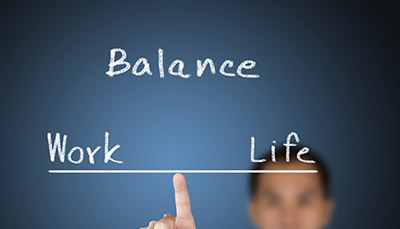 Introduction
Introduction
One of the most famous quotes regarding work life balance was made by Hillary Rodham Clinton, who said
“Don’t confuse having a career with having a life”
To most people, to have a career is the utmost priority. We are so busy making a living that we forget to make a life. Thus, there is a need to find the balance between work and life.
Work–life balance is a concept which includes proper prioritizing between “work” and “lifestyle“ (e.g health, leisure,family). The optimum work-life balance will vary over time and will be different from one individual to another. There is no one size fits all when it comes to work life balance.
Myths related to work life balance
Myth No 1: Work life balance means spending 50% of your time at work and 50% of your time at home
Reality: Work life balance occurs when individuals with a finite amount of mental, physical and emotional resources allocate those resources in way that corresponds to their personal and/or professional goals.
Myth No 2: Women desire more work life balance than men
Reality: Many studies have found that there are no gender differences in experiencing work life conflict. Both men and women are affected by the demands of both work and also non-work demands.
Myth No 3: Work life balance is synonymous with work-family balance or family support
Reality: Equating work life balance and family support as synonymous assumes only those with families desire balance. This can lead to a backlash among employees who are single or employees without children as they too need to achieve this same balance. There is a misconception that people tend to think that those with family deserved more time in their lifestyle domains compared to those who are presently single.
Assessing your balance using the work-life balance wheel
How do you assess your work-life balance? Are you doing it right? Well, one of the tools that can be used to measure this is the Wheel Of Life.
Essentially, the Wheel of Life is divided into different areas or categories that are meant to be important to you. Above is a common example of the Wheel of Life, split into the major categories of life which include Career, Finances, Personal Growth, Relationships, Health, Family and Attitude. The categories may be different based on the individual’s needs.
How do I score the Wheel of Life ?
A score of 1 to 10 is provided on the scale.The score will identify the areas for change and set goals to improve the key areas of your life.
When you have scored all areas, join the points on each section to draw a wheel. This will show you how balanced overall your life is and the areas you really need to focus on. Set goals for improvement thereafter.
Next, you will need to Identify the two areas that you’re most satisfied with and the two areas that you are least satisfied with. When the areas have been identified, you need to ask yourself the following questions:
- What do you need do to achieve a higher level of satisfaction in those areas?
- What would change for you if you became dissatisfied in those areas?
- What do you need to say no to in order to achieve more balance?
- What do you need to say yes to in order to achieve more balance?
- What will happen if you don’t say yes or not to these things?
- Do you remember the time when you feel you were most balanced? What did you do at that time? What does that makes you feel?
Symptoms of imbalance
How do you know if you are suffering from an imbalance? Unbalance may affect not only on your mental health, but also on your physical health. It depends on one’s coping skills, social support and underlying personality. Some people are more resilient than others. The following are the examples of the symptoms:
- Physical: Headaches, fatigue, sleep disturbances, palpitation, changes in appetite, muscle tension.
- Emotional: Low mood, anxiety, irritability, agitation,difficulty in making decisions, poor concentration, feelings of helplessness/hopelessness, loss of interest
- Personal: Socially withdrawn, burnout, , conflict in relationship , substance/alcohol misuse, demotivated
If there are persistent depressive/ anxiety symptoms or impairment in functioning, it is best to seek professional help.
Identify the barrier to balance
If you suffer from symptoms of imbalance, ask yourself what are the barriers that prevent you from achieving balance.
Most common barriers are:
- Time
- Feeling guilty
- Climbing the “ladder” or career goals
- Failure to set limits
- The inability to say no
Strategies to improve your balance
- Understand that some things are beyond your control to change
- Take action to reduce or remove the stressors
- Share your problem with others
- Identify your stress outlet
- Replace negative relationships with positive ones
- Develop leisure activities – hobbies, social events.
- Seek advice from others
- Learn to say no
- Leave work at work
- Identify options at work and take advantage of them (e.g : flexi hours)
- Bolster your support system
[This article belongs to The Malaysian Medical Gazette. Any republication (online or offline) without written permission from The Malaysian Medical Gazette is prohibited.]
